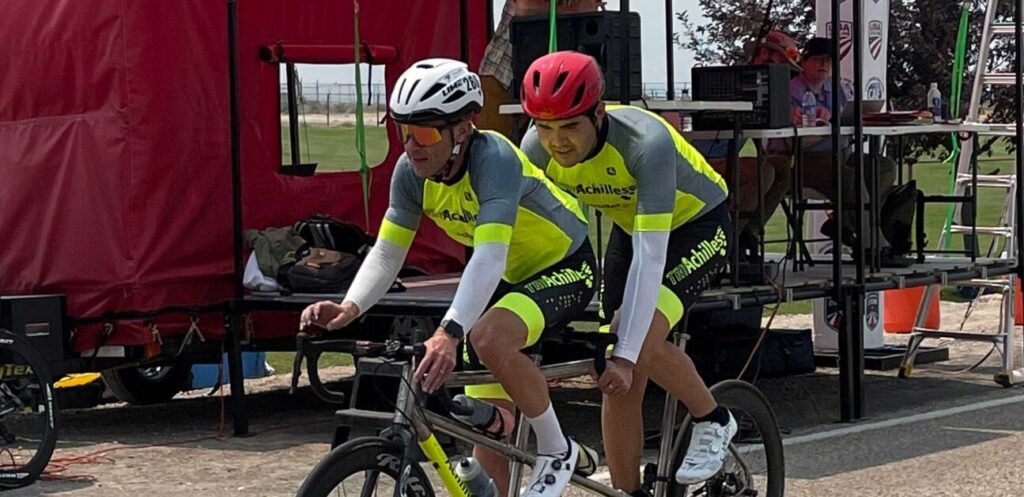Conquering Disordered Eating with Alex Sandilands

Alex Sandilands had a rapid rise to 4.8w/kg after transitioning from years of running, but that quickly fell apart after an MRI from an overuse injury exposed disturbing effects of starvation. Fortunately, Alex became aware of his disordered eating and got his health back on track to reach new heights in terms of both power and health.
Share your success story and tell us how TrainerRoad helped you reach your goals.
Running enamored Alex. Not only did he enjoy competing on an amateur level, but he dove into the history and science of the sport. After dealing with nagging running injuries, Alex transitioned over to cycling and started training with TrainerRoad.
With a massive aerobic base from running, Alex found his cycling fitness quickly once his neuromuscular coordination caught up. Additionally, he learned that he could train more because cycling was easier on his body than running. In short order, Alex was able to raise his power-to-weight ratio to 4.8 W/kg.
A Shocking Revelation
Reaching such a high power-to-weight ratio would be the envy of many cyclists. However, unknown to Alex, there was a massive problem looming. After moving to Los Angeles, Alex got back into running but continued to train on the bike. He would ride in the morning, then use the afternoons for running.
One day, while out for a long run, his hip was hurting more than usual. Without a phone or a mask, he decided to head home. Reaching home after the 18-mile run, Alex couldn’t walk due to the pain in his hip. His doctor recommended Alex get an MRI to check for a suspected stress fracture.
“The results were shocking for me.”
Alex Sandilands
By the time Alex had the MRI, he had made peace with the setback of having a stress fracture. But the shocking revelation on the report was not the stress fracture in his hip; it was the muscle atrophy, something that is tied to starvation. Alex was shocked when the doctor asked him if he had an eating disorder.
Monitoring his food like many athletes, Alex didn’t think he was doing anything out of the ordinary by weighing food and tracking it with an app. For that matter, he wasn’t trying to lose weight, he was simply using his basal metabolic rate and adding in the calories burned from training. His testosterone levels were extremely low, but fortunately, a DEXA scan revealed that his bone density was unaffected. But clearly, he was suffering from Relative Energy Deficiency in Sport (RED-S), a complex condition resulting from under-fueling and overtraining.
Learning About Disordered Eating
Soon after learning that he was starving himself with disordered eating, Alex met with a registered dietitian, which uncovered plenty of learning opportunities. Thinking that he was fueling enough, Alex used the IOC consensus statement on relative energy deficiency in sport (RED-S) to calculate his energy demands by lean body mass. He was incredibly far off the mark with his previous methods. Alex said that he “felt stupid for being that far off.”
About Disordered Eating
- Disordered eating is abnormal eating behavior that can include restricting, purging, or binging.
- Disordered eating differs from eating disorders because they do not meet the American Physicritic Association’s clinical specified definitions.
- Source: https://pubmed.ncbi.nlm.nih.gov/20840569/
Alex learned that pushing your training to the limit is an extraordinary demand and one that requires exceptional nutrition. Speaking with the dietitian opened his eye to the caloric demands. Before, Alex thought he was taking care of his nutritional needs. Typically, he felt that he could get through ninety minutes for those early morning workouts and eat something afterward. He even saw it as a badge of honor.
Adaptive Training
Get the right workout, every time with training that adapts to you.
Check Out TrainerRoadBut what Alex learned is that it’s challenging to eat enough calories to catch back up. This is especially true when you’re trying to eat nutrient-dense foods. Nutrient-dense foods like grains, lean proteins, and vegetables are typically not calorie-dense. So Alex was full from eating a big bowl of oatmeal but not getting nearly enough calories.
Recovering from Disordered Eating
Alex not only wanted to be healthier, but he also wanted to continue endurance sports as he got older. The fear of bone loss and injury was a concern, so he made some significant changes to his nutrition and training.
Fueling Workouts
Alex now fuels every workout. He started with 40 grams of carbs per hour and is now at 60g. Fueling the workouts made a big difference to his training and how he felt. He suggests trying to find a sports nutrition product that works for you. With cycling, it’s easy to believe that you can calculate everything down to calories. The truth is that our bodies are more complicated than a simple formula.
Nutrient-Dense and Calorie-Dense Foods
Before, Alex would focus on eating nutrient-dense foods, which are excellent for providing your body with its needs. The problem is that a huge bowl of kale, chicken, and vegetables will leave you full but may only have about 600 calories. On the flip side, calorie-dense foods tend to lack all the nutrients. It’s tough to find a balance, but including healthy plant-based fats can be a great option.
Reflect on Your Relationship with Food
Alex said that “it’s good to take a step back sometimes because the journey is about trying to find balance.” Sometimes, our baseline is really off the mark. This can help you see the warning signs like seeing a type of food as a non-negotiable thing or a detriment to your performance.
Talk to Other Endurance Athletes
Alex believes it’s important to have a dialogue with other athletes to help us see when we’re losing perspective. With high training volumes and under-fueling, the margin for error is minuscule. Talking with others helped Alex understand that there’s an ebb and flow to each cycling season and that your body will change with it.
Overcoming and Reaching New Heights
Now, Alex is in a much healthier place. He’s added about fifteen pounds of weight and is knocking out power PRs all the time. He’s even increased his W/kg to 5.0. Alex has noticed that he looks healthier too, and he can feel the performance. Before everything happened, Alex would do some group rides. No one could keep up with him on the climbs, but he could never hold onto the group on the flats. So much so that he would drop out and ride alone. Now, it’s an entirely different story. The extra weight has helped him push the power upwards so that he’s not only healthier but faster as well.
